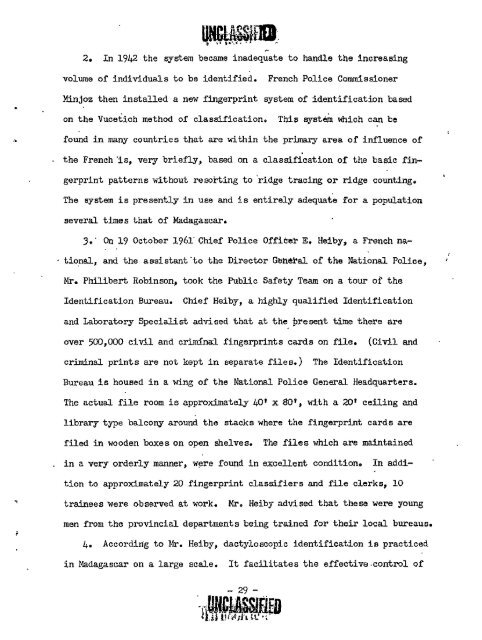MALAGASY NATIONAL POLICE
MALAGASY NATIONAL POLICE
MALAGASY NATIONAL POLICE
Create successful ePaper yourself
Turn your PDF publications into a flip-book with our unique Google optimized e-Paper software.
2. In 1942 the system became inadequate to handle the increasing<br />
volume of individuals to be identified. French Police Commissioner<br />
Minjoz then installed a new fingerprint system of identification based<br />
on the Vucetich method of classification. This system which can be<br />
found in many countries that are within the primary area of influence of<br />
the French is, very briefly, based on a classification of the basic fin<br />
gerprint patterns without resotting to ridge tracing or ridge counting.<br />
The system is presently in use and is entirely adequate for a population<br />
several times that of Madagascar.<br />
3. On 19 October 1961 Chief Police OfMiter E. Heiby, a French na<br />
tional, and the assistant'to the Director Gbiital of the National Police,<br />
Mr. Philibert Robinson, took the Public Safety Team on a tour of the<br />
Identification Bureau. Chief Heiby, a highly qualified Identification<br />
and Laboratory Specialist advised that at the resent time there are<br />
over 500,000 civil and criminal fingerprints cards on file. (Civil and<br />
criminal prints are not kept in separate files.) The Identification<br />
Bureau is housed in a wing of the National Police General Headquarters.<br />
The actual file room is approximately 40' x 80', with a 20' ceiling and<br />
library type balcony around the stacks where the fingerprint cards are<br />
filed in wooden boxes on open shelves. The files which are maintained<br />
in a very orderly manner, were found in excellent condition. In addi<br />
tion to approximately 20 fingerprint classifiers and file clerks, 10<br />
trainees were observed at work. Mr. Heiby advised that these were young<br />
men from the provincial departments being trained for their local bureaus.<br />
4. According to Mr. Heiby, dactyloscopic identification is practiced<br />
in Madagascar on a large scale. It facilitates the effective.control of<br />
- 29

















